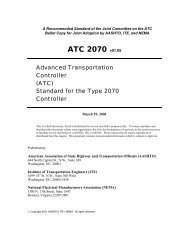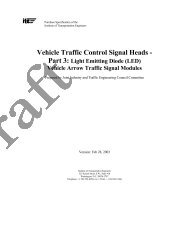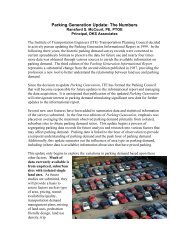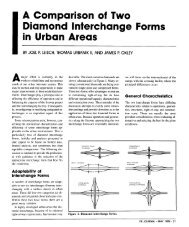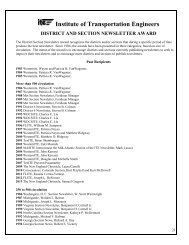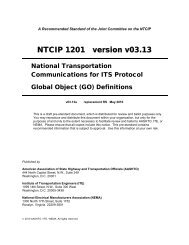Vehicle Traffic Control Signal Heads: - Institute of Transportation ...
Vehicle Traffic Control Signal Heads: - Institute of Transportation ...
Vehicle Traffic Control Signal Heads: - Institute of Transportation ...
Create successful ePaper yourself
Turn your PDF publications into a flip-book with our unique Google optimized e-Paper software.
Peak minimum maintained luminous intensity<br />
values, at θ Vert = –2.5 deg and θ Horiz = 0 deg<br />
[I (-2.5, 0) ], by size and color <strong>of</strong> the module are:<br />
I (-2.5, 0)<br />
Color 200mm 300mm<br />
Red 165 cd 365 cd<br />
Yellow 410 cd 910 cd<br />
Green 215 cd 475 cd<br />
4.1.1.4 Multiply the vertical intensity factor times<br />
the horizontal intensity factor (for the selected<br />
pair <strong>of</strong> angles). Round the result to two significant<br />
figures, and multiply the combined angular<br />
intensity factor times the peak minimum<br />
maintained luminous intensity value for the<br />
appropriate signal size and color:<br />
I (θvert, θhoriz, size, color) = [f(I Vert )× f(I Horiz )] ×I (-2.5, 0)<br />
The resultant value <strong>of</strong> the luminous intensity shall<br />
be rounded to the nearest whole number.<br />
Example: What is the minimum maintained<br />
luminous intensity value for a green, 300 mm<br />
LED signal light at 5 degrees down and 10<br />
degrees left?<br />
I (−5, 10, 300, Green) = [f(I vert = -5 )× f(I horiz = 10 )]×475 cd<br />
I (−5, 10, 300, Green) = [0.953×0.678]×475 cd<br />
I (−5, 10, 300, Green) = 0.65×475 = 309 cd<br />
4.1.1.5 Table 1 (page 13) provides the minimum<br />
maintained luminous intensity values over the<br />
required angular range at 5-degree increments.<br />
Note that the horizontal limitations vary for<br />
various vertical angles (for example, at θ Vert =<br />
+12.5 degrees, requirements are only specified<br />
from 7.5 degrees right to 7.5 degrees left, while at<br />
θ Vert = -12.5 degrees, the horizontal limitations are<br />
from 27.5 degrees right to 27.5 degrees left).<br />
Table 2 (page 14) provides the minimum<br />
maintained luminous intensity values, over the<br />
required angular range, at 2.5-degree increments.<br />
Tables 1 and 2 are provided to illustrate the<br />
minimum required values at certain specific<br />
angles within the required angular range <strong>of</strong><br />
performance (while testing for light output<br />
compliance <strong>of</strong> a module in a laboratory, an<br />
agency may use Table 1, and/or other specific<br />
pairs <strong>of</strong> vertical and horizontal angles <strong>of</strong> its<br />
choosing within the required angular range). One<br />
must use the procedure outlined for determining<br />
the minimum maintained luminous intensity<br />
values at any specific pairs <strong>of</strong> vertical and<br />
horizontal angles within the required angular<br />
range.<br />
4.1.2 Maximum permissible luminous intensity:<br />
When operated within the temperature range<br />
specified in Section 3.3.2, the actual luminous<br />
intensity for a module shall not exceed three times<br />
the required peak value <strong>of</strong> the minimum<br />
maintained luminous intensity for the selected<br />
signal size and color.<br />
4.1.3 Luminance uniformity: The uniformity <strong>of</strong><br />
the signal output across the entire module lens<br />
shall not exceed a ratio <strong>of</strong> 10 to 1 between the<br />
maximum and minimum luminance values<br />
(cd/m 2 ).<br />
4.2 Chromaticity<br />
4.2.1 Color regions: The measured chromaticity<br />
coordinates <strong>of</strong> modules shall conform to the<br />
following color regions, based on the 1931 CIE<br />
chromaticity diagram (see Figure 1, page 18):<br />
Red: y = 0.308;<br />
y = 0.953 – 0.947x;<br />
y = 0.290:<br />
Red<br />
Point x y<br />
1 0.692 0.308<br />
2 0.681 0.308<br />
3 0.700 0.290<br />
4 0.710 0.290<br />
Yellow: y = 0.151 + 0.556x;<br />
y = 0.972 – 0.976x;<br />
y = 0.235 + 0.300x:<br />
Yellow<br />
Point x y<br />
1 0.545 0.454<br />
2 0.536 0.449<br />
3 0.578 0.408<br />
4 0.588 0.411<br />
4



